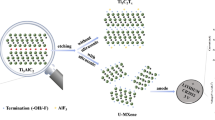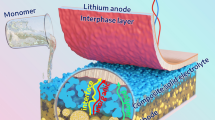Abstract
The Li4Ti5O12/polyaniline and Li4Ti5O12/С/polyaniline composite materials with different lithium titanate/aniline ratio of 8:1, 4:1, 2:1, 1:1, 1:2, and 1:4 were synthesized by in situ polyaniline (PANI) polymerization. The materials were characterized by high-resolution TEM, X-ray powder diffraction, IR spectroscopy, and TGA. It was shown that polyaniline is uniformly distributed over the surface of Li4Ti5O12 or Li4Ti5O12/С composite. For the sample with the minimum polyaniline content (Li4Ti5O12/С/PANI (8:1)), the PANI layer thickness is 2–3 nm and contains polyaniline in the most conductive (emeraldine) form. The lithium titanate modification with polyaniline results in sharp increase in the electronic conductivity of materials from ~ 10−11 Ohm-1 cm−1 for Li4Ti5O12 to 10−4 Ohm-1 cm−1 for Li4Ti5O12/C/PANI. With increasing polyaniline content, the electrochemical capacity decreases for all samples, including carbon-coated and uncoated ones. The highest discharge capacity at current density < 800 mA g−1 is attained for the Li4Ti5O12/С/PANI (8:1) composite.









Similar content being viewed by others
References
Ohzuku T, Ueda A, Yamamoto N (1995) Zero-strain insertion material of Li[Li1/3Ti5/3]O4 for rechargeable lithium cells. J Electrochem Soc 142:1431–1435. https://doi.org/10.1149/1.2048592
Colbow KM, Dahn JR, Haering RR (1989) Structure and electrochemistry of the spinel oxides LiTi2O4 and Li4/3 Ti5/3 O4. J Power Sources 26:397–402. https://doi.org/10.1016/0378-7753(89)80152-1
Chen CH, Vaughey JT, Jansen AN, Dees DW, Kahaian AJ, Goacher T, Thackeray MM (2001) Studies of Mg-substituted Li4−xMgxTi5O12 spinel electrodes (0≤x≤1) for lithium batteries. J Electrochem Soc 148:A102–A104. https://doi.org/10.1149/1.1344523
Bach S, Pereira-Ramos JP, Baffier N (1999) Electrochemical properties of sol–gel Li4/3Ti5/3O4. J Power Sources 81:273–276. https://doi.org/10.1016/S0378-7753(98)00216-X
Dominko R, Bele M, Gaberscek M, Remskar M, Hanzel D, Pejovnik S, Jamnik J (2005) Impact of the carbon coating thickness on the electrochemical performance of LiFePO4/C composites. J Electrochem Soc 152:A607–A610. https://doi.org/10.1149/1.1860492
Oh SW, Myung S-T, Oh S-M, Oh KH, Amine K, Scrosati B, Sun Y-K (2010) Double carbon coating of LiFePO4 as high rate electrode for rechargeable lithium batteries. Adv Mater 22:4842–4845. https://doi.org/10.1002/adma.200904027
Li B, Han C, He Y-B, Yang C, Du H, Yang Q-H, Kang F (2012) Facile synthesis of Li4Ti5O12/C composite with super rate performance. Energy Environ Sci 5:9595–9602. https://doi.org/10.1039/C2EE22591C
Wang Y, Wang Y, Hosono E, Wang K, Zhou H (2008) The design of a LiFePO4/carbon nanocomposite with a core–shell structure and its synthesis by an in situ polymerization restriction method. Angew Chem Int Ed 47:7461–7465. https://doi.org/10.1002/anie.200802539
Yaroslavtsev AB, Kulova TL, Skundin AM (2015) Electrode nanomaterials for lithium-ion batteries. Russ Chem Rev 84:826–852. https://doi.org/10.1070/RCR4497
Wang LG, Zuo PJ, Yin GP, Ma YL, Cheng XQ, Du CY, Gao YZ (2015) Improved electrochemical performance and capacity fading mechanism of nano-sized LiMn0.9Fe0.1PO4 cathode modified by polyacene coating. J Mater Chem A 3(4):1569–1579. https://doi.org/10.1039/C4TA05900J
Chen Z, Du B, Xu M, Zhu H, Li L, Wang W (2013) Polyacene coated carbon/LiFePO4 cathode for Li ion batteries: understanding the stabilized double coating structure and enhanced lithium ion diffusion kinetics. Electrochim Acta 109:262–268. https://doi.org/10.1016/j.electacta.2013.07.159
Xie HM, Wang RS, Ying JR, Zhang LY, Jalbout AF, Yu HY, Yang GL, Pan XM, Su ZM (2006) Optimized LiFePO4–polyacene cathode material for lithium-ion batteries. Adv Mater 18(19):2609–2613. https://doi.org/10.1002/adma.200600578
Zhu ZR, Yi TF, Ma HT, Ma YQ, Jiang LJ, Zhu RS (2014) Improved electrochemical performance of Ag-modified Li4Ti5O12 anode material in a broad voltage window. J Chem Sci 126:17–23. https://doi.org/10.1007/s12039-013-0539-y
Krajewski M, Michalska M, Hamankiewicz B, Ziolkowska D, Korona KP, Jasinski JB, Kaminska M, Lipinska L, Czerwinski A (2014) Li4Ti5O12 modified with Ag nanoparticles as an advanced anode material in lithium-ion batteries. J Power Sources 245:764–771. https://doi.org/10.1016/j.jpowsour.2013.07.048
Huang SH, Wen ZY, Zhu XJ, Yang XL (2005) High rate capability and long-term cyclability of Li4Ti4.9V0.1O12 as anode material in lithium ion battery. J Electrochem Soc 152:A1301–A1305. https://doi.org/10.1016/j.electacta.2011.07.051
MacDiarmid AG (2002) Synthetic metals: a novel role for organic polymers. Synth Met 125:11–22. https://doi.org/10.1016/S0379-6779(01)00508-2
Chiang JC, MacDiarmid AG (1986) Polyaniline. Protonic acid doping of the emeraldine form to the metallic regime. Synth Met 13:193–205. https://doi.org/10.1016/0379-6779(86)90070-6
Tantawy HR, Aston DE, Smith JR, Young JL (2013) Comparison of electromagnetic shielding with polyaniline nanopowders produced in solvent-limited conditions. Appl Mater Interfaces 5:4648–4658. https://doi.org/10.1021/am401695p
Joseph N, Varghese J, Sebastian MT (2015) Self assembled polyaniline nanofibers with enhanced electromagnetic shielding properties. RSC Adv 5:20459–20466. https://doi.org/10.1039/C5RA02113H
Pandey K, Yadav P, Mukhopadhyay I (2014) Influence of the magnitude and direction of electric field on the transport and growth property of deposited polyaniline films. J Solid State Electrochem 18:453–463. https://doi.org/10.1007/s10008-013-2270-5
Lai C, Li GR, Dou YY, Gao XP (2010) Mesoporous polyaniline or polypyrrole/anatase TiO2 nanocomposite as anode materials for lithium-ion batteries. Electrochim Acta 55:4567–4572. https://doi.org/10.1016/j.electacta.2010.03.010
Ferchichi K, Hbaieb S, Amdouni N, Pralong V, Chevalier Y (2014) Pickering emulsion polymerization of polyaniline/LiCoO2 nanoparticles used as cathode materials for lithium batteries. Ionics 20:1301–13014. https://doi.org/10.1007/s11581-014-1074-7
Gao X-W, Wang J-Z, Chou S-L, Liu H-K (2012) Synthesis and electrochemical performance of LiV3O8/polyaniline as cathode material for the lithium battery. J Power Sources 220:47–53. https://doi.org/10.1016/j.jpowsour.2012.07.114
Yi L, Liu L, Guo G, Chen X, Zhang Y, Yu S, Wang X (2017) Expanded graphite@SnO2@polyaniline composite with enhanced performance as anode materials for lithium ion batteries. Electrochim Acta 240:63–71. https://doi.org/10.1016/j.electacta.2017.04.012
Hui Y, Cao L, Xu Z, Huang J, Ouyang H, Li J, Hu H (2017) In situ synthesis of core-shell Li4Ti5O12@polyaniline composites with enhanced rate performance for lithium-ion battery anodes. J Mater Sci Technol 33:231–238. https://doi.org/10.1016/j.jmst.2016.08.005
He Z, Xiong L, Chen S, Wu X, Liu W, Huang K (2010) In situ polymerization preparation and characterization of Li4Ti5O12-polyaniline anode material. Trans Nonferrous Metals Soc China 20:s262–s266. https://doi.org/10.1016/S1003-6326(10)60052-0
Matsunaga T, Daifuku H, Nakajima T, Kawagoe T (1990) Development of polyaniline–lithium secondary battery. Polym Adv Technol 1:33–39. https://doi.org/10.1002/pat.1990.220010106
Innis PC, Mazurkiewicz J, Nguyen T, Wallace GG, MacFarlane D (2004) Enhanced electrochemical stability of polyaniline in ionic liquids. Curr Appl Phys 4:389–393. https://doi.org/10.1016/j.cap.2003.11.056
Kozarenko OA, Dyadyun VS, Papakin MS, Posudievsky OY, Koshechko VG, Pokhodenko VD (2015) Effect of potential range on electrochemical performance of polyaniline as a component of lithium battery electrodes. Electrochim Acta 184:111–116. https://doi.org/10.1016/j.electacta.2015.10.058
Stenina IA, Kulova TL, Skundin AM, Yaroslavtsev AB (2016) High grain boundary density Li4Ti5O12/anatase-TiO2 nanocomposites as anode material for Li-ion batteries. Mater Res Bull 75:178–184. https://doi.org/10.1016/j.materresbull.2015.11.050
Armes SP, Elyashevich GK, Janca J, Gospodinova N, Helmstedt M, Krivka I, Mokreva P, Prokes J, Riede A, Rozova E, Sapurina I, Shishkanova T, Spirkova M, Stejskal J, Sulimenko T, Terlemezyan L, Tobolkova E, Trchova M (2002) Polyaniline. Preparation of a couducting polymer. Pure Appl Chem 74:857–867. https://doi.org/10.1351/pac200274050857
Stejskal J, Kratochvil P, Jenkins AD (1996) The formation of polyaniline and the nature of its structures. Polymer 37(2):367–369. https://doi.org/10.1016/0032-3861(96)81113-x
Ping Z (1996) In situ FTIR–attenuated total reflection spectroscopic investigations on the base–acid transitions of polyaniline. Base–acid transition in the emeraldine form of polyaniline. J Chem Soc Faraday Trans 92:3063–3067. https://doi.org/10.1039/FT9969203063
Saprigin A, Kohlman RS, Long SM, Brenneman KR, Epstein AJ, Angelopoulos M, Liao Y-H, Zheng W, MacDiarmid AG (1997) Optical and EPR studies of LiCl pseudodoping of emeraldine base. Synth Met 84:767–768. https://doi.org/10.1016/S0379-6779(96)04137-9
Chen S-A, Lin L-C (1995) Polyaniline doped by the new class of dopant, ionic salt: structure and properties. Macromolecules 28:1239–1245. https://doi.org/10.1021/ma00108a062
Acknowledgements
This work was supported by the Russian Foundation for Basic Research (project no. 16-29-05241).
Author information
Authors and Affiliations
Corresponding author
Ethics declarations
Conflict of interest
The authors declare that they have no conflict of interest.
Rights and permissions
About this article
Cite this article
Stenina, I.A., Shaydullin, R.R., Kulova, T.L. et al. Influence of carbon coating and PANI modification on the electrochemical performance of Li4Ti5O12. Ionics 25, 2077–2085 (2019). https://doi.org/10.1007/s11581-018-2638-8
Received:
Revised:
Accepted:
Published:
Issue Date:
DOI: https://doi.org/10.1007/s11581-018-2638-8




